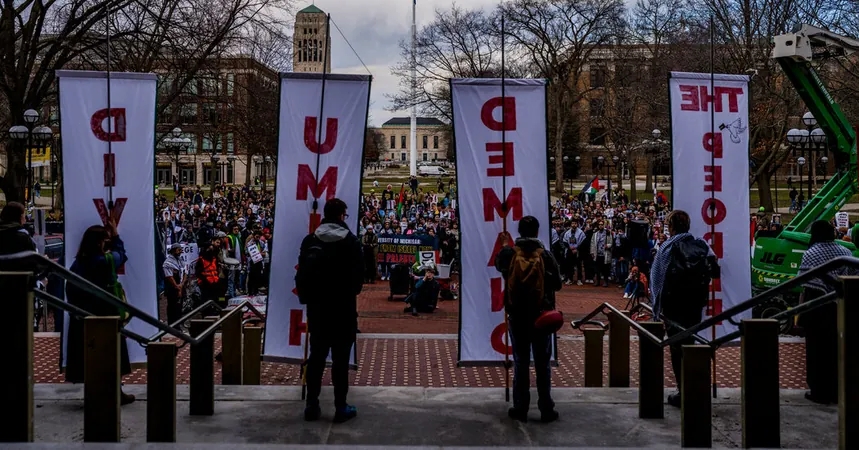
NASA's Orion Spacecraft Faces Brutal Abort Test: A Glimpse into the Future of Lunar Exploration!
2024-12-23
Author: Ling
NASA's Orion Spacecraft Faces Brutal Abort Test: A Glimpse into the Future of Lunar Exploration!
NASA has officially put its Orion spacecraft to the ultimate test as preparations ramp up for its upcoming Artemis 2 mission, designed to send a crew of four astronauts on a historic trip around the Moon. Recently, engineers conducted a rigorous series of tests at the Neil Armstrong Test Facility in Sandusky, Ohio, simulating extreme conditions that the Orion capsule might encounter during a crucial launch abort scenario—an essential part of mission safety.
During these high-stakes tests, the Orion Environmental Test Article (ETA) was put through the wringer to ensure that it can effectively safeguard astronauts by pushing itself away from the Space Launch System (SLS) rocket in case of a failure during launch. The goal? To make sure that Orion can safely splash down in the ocean, even in dire situations.
“This event would be the maximum stress and highest load that any of the systems would see,” stated Robert Overy, the Orion ETA project manager at NASA’s Glenn Research Center. He emphasized the stack of challenges that the spacecraft is built to face, “We’re taking a proven vehicle from a successful flight and pushing it to its limits. The safety of the astronaut crew depends on this test campaign.”
As part of the testing process, NASA simulated the extreme noise levels and disturbing electromagnetic effects associated with a launch abort scenario, including the impact of lightning strikes. Intriguingly, the slow-motion footage captured during the tests reveals significant action: the spacecraft’s docking module, parachute covers, and dramatic deployment of five airbags designed to cushion the return to Earth were all flung into the air—a vital step in ensuring a safe landing.
The results so far have been promising. “It’s been a successful test campaign,” Overy reported, stating that the collected data aligns well with their predictions and that all systems performed as intended. “We are still analyzing data, but the preliminary results show the vehicle and facility operated as desired,” he added, raising hopes for the future of lunar exploration.
NASA has been working toward such a milestone for over a decade, creating the Reverberant Acoustic Test Facility—the world’s most powerful spacecraft acoustic test chamber—specifically for these critical evaluations. Michael See, the ETA vehicle manager for NASA’s Orion Program, highlighted the importance of these tests: “These tests are absolutely critical because we have to complete all of these tests to determine that the spacecraft design is safe for our first crewed mission on Artemis II.”
Looking back to November 2022, Orion successfully completed its uncrewed Artemis 1 mission, which covered a staggering 1.4 million miles on its journey to the Moon and back. However, despite the apparent success, challenges persist, such as an unexpected performance by Orion’s heat shield during reentry. Originally, Artemis 2 was scheduled for a September 2025 launch, but due to program delays, that has slipped to April 2026. This mission is pivotal for paving the way to Artemis 3, which aims for the first human landing on the Moon since the Apollo missions, now pushed to mid-2027.
NASA’s Artemis program is vying to return humanity to the lunar surface, particularly with concerns about China's advancements in space exploration. However, the program has faced tough challenges, including setbacks with the SLS rocket, issues with Orion’s heat shield, and numerous budget overruns. Despite these hurdles, Orion is now poised to demonstrate its emergency protocol, ensuring that astronauts will have a contingency plan when venturing into the vastness of space.
Stay tuned as we follow the progress of NASA's Artemis missions—this journey could redefine our place in the cosmos!




 Brasil (PT)
Brasil (PT)
 Canada (EN)
Canada (EN)
 Chile (ES)
Chile (ES)
 España (ES)
España (ES)
 France (FR)
France (FR)
 Hong Kong (EN)
Hong Kong (EN)
 Italia (IT)
Italia (IT)
 日本 (JA)
日本 (JA)
 Magyarország (HU)
Magyarország (HU)
 Norge (NO)
Norge (NO)
 Polska (PL)
Polska (PL)
 Schweiz (DE)
Schweiz (DE)
 Singapore (EN)
Singapore (EN)
 Sverige (SV)
Sverige (SV)
 Suomi (FI)
Suomi (FI)
 Türkiye (TR)
Türkiye (TR)